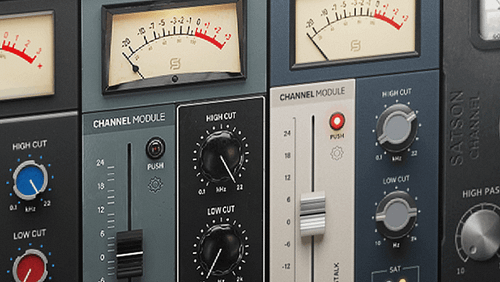A stereo audio file achieves the illusion of three-dimensional space thanks to the use of two channels that play in sync from a left and right speaker. During mixing, when something gets panned hard left or hard right, it’s sent to only one of the two speakers. While if something gets played at the center, like the vocals on a song or podcast, its signal is sent equally to both channels. That is why when listening to music through only one headphone, or isolating just one of the two channels, the voice or the drums are normally equally present.
On the other hand, when that same stereo file plays through only one speaker, like your phone or a Bluetooth speaker, the left and right information gets summed and you are able to listen to everything together. The audio turns into mono. As a result, mixes sound more upfront but they lose a bit of depth due to the phase cancellation that might occur between the left and the right channels.
This kind of processing is actually used in a technique that can help make mixes feel wider or add presence to your mix without the need of tweaking the faders in your session. Black magic? No. We are talking about Mid/Side processing.
What is Mid/Side Processing?
For those of you not familiar with it, Mid/Side (M/S) stands for Middle and Sides and it is a technique that separates the centered sources of a stereo file from the left and right panned elements. It is a common technique used in mastering but also many mixing engineers take advantage of it.
To achieve this separation the two channels of a stereo track need to be summed in two independent mono tracks. This process is normally called the M/S encoder.
The first track, as we saw earlier, combines both left and right channels and it provides the Middle information of the stereo track. The second mono track is the result of flipping the polarity of either the right or left channel and summing both signals. This gives the Sides of the original stereo track. Pan both resulting mono tracks left and right and we have the Middle and Sides.
With the information separated we can now process each channel independently and control the dynamics, tone and level of the centered and panned elements of your stereo track independently.
But, if we leave them like that, the Middle track will play on the left channel and the Sides will play on the right, not sounding as the original mix intended. To go back to the stereo sound we need to follow the opposite steps. Instead of summing to mono, the Middle and Sides channels are sent to a stereo track and panned accordingly. This is called the M/S decoder. Once everything is in place, any processing applied in between the encoder and the decoder will have an audible effect in the stereo mix.
M/S in Action
This technique can be achieved on any DAW by following the previous routing. But If this is confusing, fear not! There are many free M/S plug-ins online that provide the encoder and decoder and will do the routing for you. Just add the encoder at the beginning of your plug-in chain and an instance of the decoder at the end.
The great thing about Mid/Side processing is that you can use any of your favourite plug-ins with it. Whether you are working with an encoder-decoder or you have made your own routing, using multi-mono plug-ins will allow the processing of the Mid and Side channels (Left and Right after the encoder) independently. You can use plugins like Burnley 73 or SonEQ 2 to EQ your Mid/Sides, to add clarity on your vocals or air to your reverbs without affecting the other.
On top of that Tuco and the compressor module from Satson CS provide the possibility of Dual Mono Mode which is perfect for Mid/Side processing even without the multi-mono setup. Just set the compressor in between the M/S encoder and decoder, set the mode to Dual Mono and you are ready to go. In Dual Mono, the compressor acts over each channel independently using the same settings, which can be interesting for adding cohesion to the Middle and leaving the Sides more dynamic. You can even experiment with the Mix knob to add parallel compression using more extreme settings.
Did you know about Mid/Side processing? Do you use it in your mixes or mastering projects? Let us know in the comments below and share how you use Sonimus plugins for Mid and Sides.








Leave A Comment
You must be logged in to post a comment.